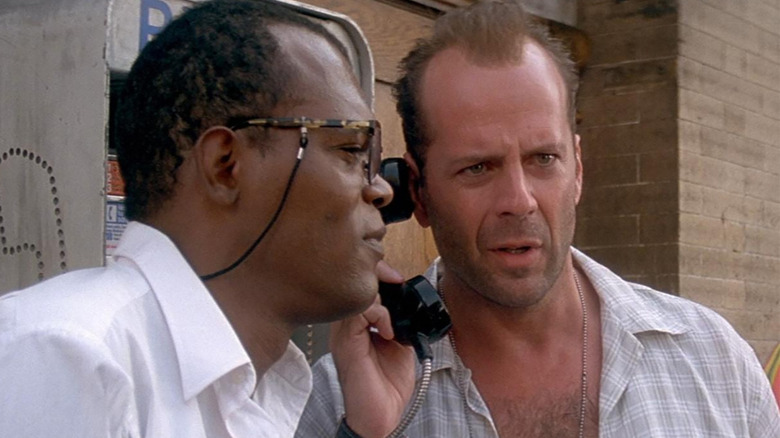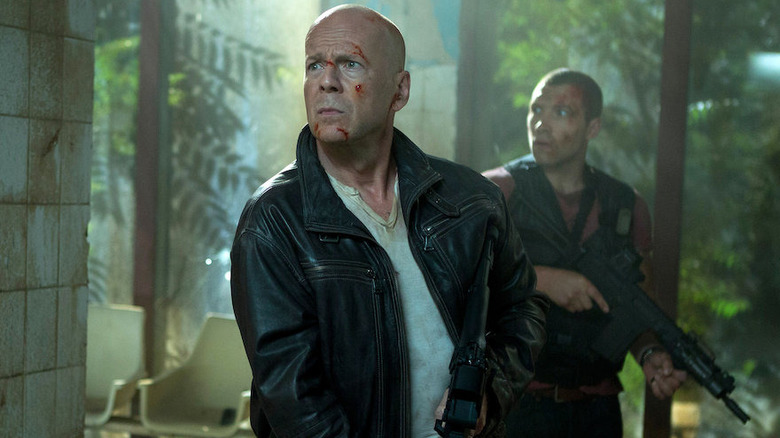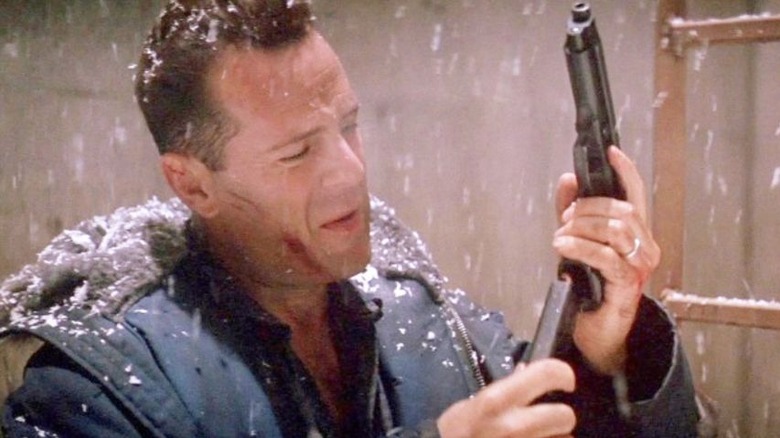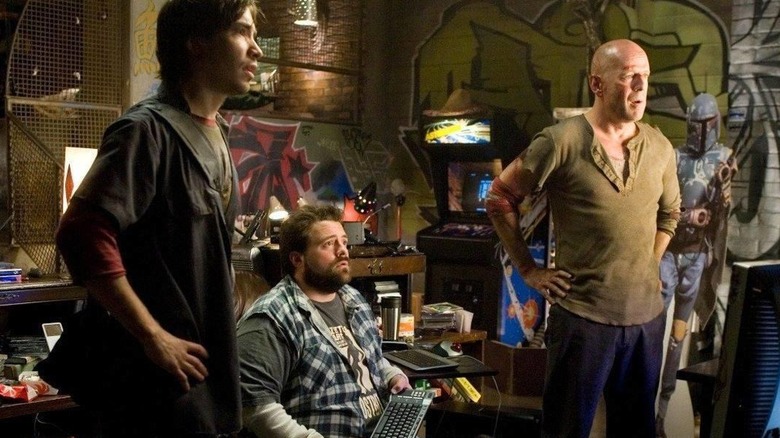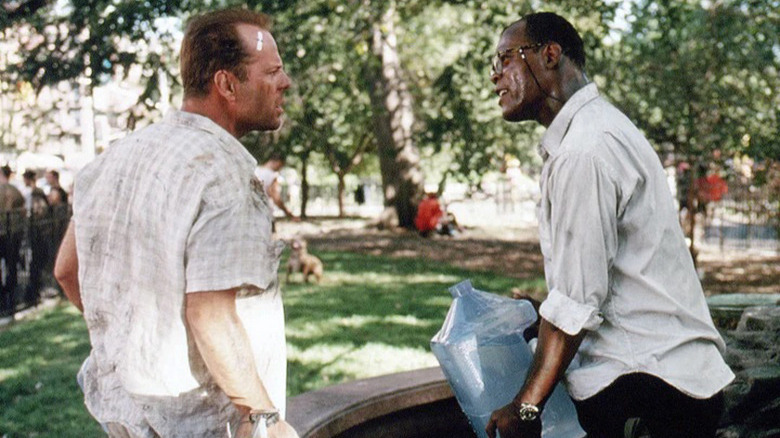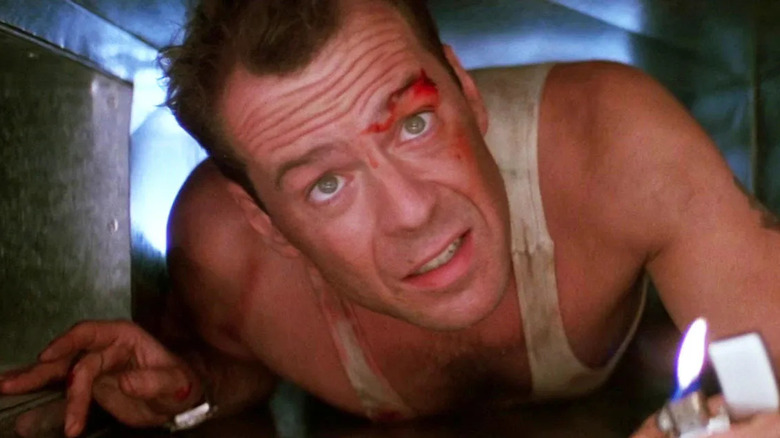Every Die Hard Movie Ranked From Worst To Best
"Die Hard" is one of the most beloved action films of all time. Above and beyond the regular "Is it a Christmas movie?" discourse that surrounds the film, "Die Hard" stands as a watershed moment in the action genre. The casting of Bruce Willis as the everyman action hero — as opposed to the Schwarzeneggers and Stallones of the day, muscle-bound demigods whose victories seemed absolutely certain — brought a new level of humanity and an underdog spirit to American action movies that persists today.
On the opposite side of that coin lies the film's antagonist, Hans Gruber (Alan Rickman), one of cinema's great villains and a prototype of the dashing, "love to hate them" style of action baddies. Add in the script's bracing wit, John McTiernan's taut direction, and some of the most thrilling stunts in action history, and you have a stone-cold classic.
Inevitably, a franchise grew out of the film, with four subsequent movies being released to continue the John McClane saga. With a total of five movies released over the course of 25 years, "Die Hard" isn't the most prolific franchise in Hollywood, but it does feature both an evolution of McClane as a character (more successfully in some films than in others) and a shifting portrait of how Bruce Willis — and the movies with which he is synonymous — have changed over the years. As shown by the list below, some of the films' changes haven't been for the better.
5. A Good Day to Die Hard (2013)
The final entry in the series finds Detective John McClane (Bruce Willis) traveling to Russia to help his estranged son Jack (Jai Courtney), who is in serious trouble with Russian authorities. As soon as John arrives, a bomb goes off, and Jack and John race through Moscow as corrupt government official Viktor Chagarin's (Sergei Kolesnikov) henchmen try to kill them. Once they arrive at a safe house, John learns that Jack is not the "screw-up" he thought he was; he is actually a CIA operative who is trying to get information out of whistleblower Yuri Komarov (Sebastian Koch) that can bring Chagarin down once and for all. Intrigue, double-crosses, and bombastic set pieces ensue.
Though it's shorter than any other film in the franchise by nearly 30 minutes, "A Good Day to Die Hard" feels longer than all the rest put together. It's an aimless slog with ill-defined stakes and generic characters that leave the audience with no one to root for. Perhaps even worse, it doesn't feel like a "Die Hard" movie at all. A big part of John McClane's appeal is his everyman persona: he struggles, he fails, and he takes time to figure out what to do in the face of seemingly insurmountable odds.
In this fifth entry in the series, all of that is gone, replaced with an indestructible and mostly humorless John McClane who outmaneuvers career spies without breaking a sweat. Another sin? The film completely wastes Mary Elizabeth Winstead as John's daughter Lucy, who proved in the previous entry that she has the action chops to hold her own with Willis.
4. Die Hard 2 (1990)
Directed by Renny Harlin, "Die Hard 2" picks up two years after the events of the first film. Having reunited with his wife Holly (Bonnie Bedelia), John McClane is now an LAPD cop. When he arrives at Dulles International Airport to pick her up for a Christmas visit with her parents, he gets into a gunfight with some suspicious men in a restricted area of the airport. John soon learns that they work for Colonel William Stuart (William Sadler), a disgraced military leader who plans to meet the plane carrying General Ramon Esperanza (Franco Nero), a deposed dictator who has been extradited to the U.S. on drug charges. Stuart and his men support Esperanza's anti-communist stance, and their attempts to ferry the general to a non-extradition country are thwarted at every turn by McClane and the allies he recruits to stop the terrorists from crashing all the planes flying into Dulles — including Holly's.
This direct sequel's biggest offense is that it tries too hard to recreate the magic of the original "Die Hard," following the pattern set by McTiernan's film as closely as possible without bringing anything new to the franchise. An off-duty cop shows up at a large structure and unexpectedly finds himself beset by terrorists? Check. McClane must battle his way through bureaucratic red tape, incompetent law enforcement officials, and disbelieving authorities in order to save Holly from certain death? Check.
"Die Hard 2" even brings back the antagonistic dynamic between Holly and television reporter Richard Thornburg (William Atherton), who finds himself stuck on the same flight as Holly. Though she gets in some satisfying digs at the expense of the pompous Thornburg, the film as a whole is too self-conscious about matching the humor of the original. Its quips and one-liners feel overly manufactured. Though it's still a delight to watch John McClane be John McClane (especially before he turned into just another indestructible action hero in later sequels), "Die Hard 2" can't dig itself out from underneath the weight of its predecessor, leaning instead on the original's proven formula and some ill-advised self-referential humor.
3. Live Free or Die Hard (2007)
The fourth film in the series finds John McClane working as an NYPD detective who has been assigned to bring a computer hacker named Matthew Farrell (Justin Long) into custody. When McClane arrives, assassins attack Farrell, and the two men must try to outrun and outwit Thomas Gabriel (Timothy Olyphant), a cyber-terrorist who systematically shuts down the entire country's infrastructure in an act of revenge against the United States government.
If this were a list of Best Deployments of John McClane's Catchphrase ("Yippee-ki-yay, motherf*****!"), "Live Free or Die Hard" might nab the top spot. The catchphrase makes an appearance in every film in the franchise, but the potency and boldness of McClane uttering it as he shoots through his own shoulder to kill a bad guy is unmatched even by the original use of the now iconic line. Another highlight of "Live Free or Die Hard" is the way it evolves with technology and a changing cinematic landscape. It presents McClane as a relic in a world that's moving on without him. He is in over his head with the computer aspect of the plot and has to learn as he goes, ironically using the speed of technological advancement to return to the franchise's roots of an everyman fighting against forces he doesn't understand.
Seeing Bruce Willis return to the role as a visibly older actor puts an interesting spin on the idea. Though this likely gives the over-the-top popcorn flick too much credit, it does raise some interesting points about Willis as an action star and about the genre itself. While it shaves off some of McClane's everyman qualities, "Live Free or Die Hard" still seems to argue that technology (whether related to computing or filmmaking) may change, but you can't improve on the classics.
2. Die Hard with a Vengeance (1995)
John McTiernan returns to the franchise in its third installment, which depicts a very different John McClane. He's separated from Holly and back in New York, where he is suspended from the NYPD and spends his days drinking. A mysterious bomber named Simon (Jeremy Irons) calls his department and asks for McClane specifically, sending him on a wild goose chase that involves puzzles and dangerous tasks. The first task introduces McClane to Zeus Carver (Samuel L. Jackson), who becomes his reluctant partner as McClane tries to prevent any other bombings. They soon learn that Simon is Simon Gruber, Hans Gruber's brother who is out for revenge.
McTiernan's directorial verve is less restrained in "Die Hard with a Vengeance," resulting in a sometimes overwhelming but always entertaining movie that features literally and figuratively explosive action sequences. In spite of a highly regrettable "reverse racism" subplot that weaves throughout the film in cringe-inducing dialogue, the best thing about the movie is the dynamic between Bruce Willis and Jackson. McClane has always been a cowboy, but his rebellious attitude has tipped over into dangerous recklessness now that he is estranged from his wife and children.
Simon puts McClane into highly volatile situations, and McClane never seems entirely sure that he wants to make it out in one piece. Jackson's measured and confident Zeus has his own rebellious "screw you" attitude, but he knows that as a Black man he has to maintain an even keel to survive in a world filled with white, "trigger-happy" cops. As a result, he perfectly counterbalances McClane's unpredictable energy. The tension between the two men, coupled with their complementary approaches to life and their burgeoning respect for one another, makes for a fascinating and electric movie.
1. Die Hard (1988)
"Die Hard," the first and still the best in the franchise, introduces the viewer to John McClane, a New York cop flying to Los Angeles to see his wife for the first time in six months. He's scheduled to attend a Christmas party at her office, but elite thieves masquerading as terrorists (led by Alan Rickman's Hans Gruber) crash the party so that they can rob the company's vault. McClane becomes "the fly in the ointment," doing whatever he can to thwart Gruber's plan and save Holly and the rest of the guests from the murderous thieves and the incompetent L.A. law enforcement officials who are steadily making the situation worse.
"Die Hard" combines some of the best things that Hollywood has to offer. It's a precision heist film combined with one of the tightest and most thrilling action movies in history. It pits one of the silver screen's most delicious villains against an everyman underdog who uses ingenuity, toughness, and resilience to save the day. You could fill this whole list with reasons why "Die Hard" is such a great film: it's tightly plotted, with writing, directing, and cinematography that are too brilliant to be called merely "efficient," though their smooth clockwork storytelling is a large part of what makes them so great. The performances are spectacular (in addition to Rickman and Bruce Willis, Hart Bochner deserves special mention as the unctuous executive Harry Ellis).
The action scenes are just as thrilling and ingenious today as they were in 1988. But the biggest reason "Die Hard" still endures is the fact that viewers can see themselves in John McClane. He's not the smartest or biggest or strongest man in the room; he doesn't have the most expensive equipment or the heaviest artillery. What he does have is a refusal to give up. He figures things out as he goes along. He gets banged up along the way, but he ultimately triumphs. "Die Hard" works precisely because John McClane falls down so many times. You don't have to have the priciest toys or the biggest muscles to win, this action classic tells the audience. It's the getting back up that matters.
